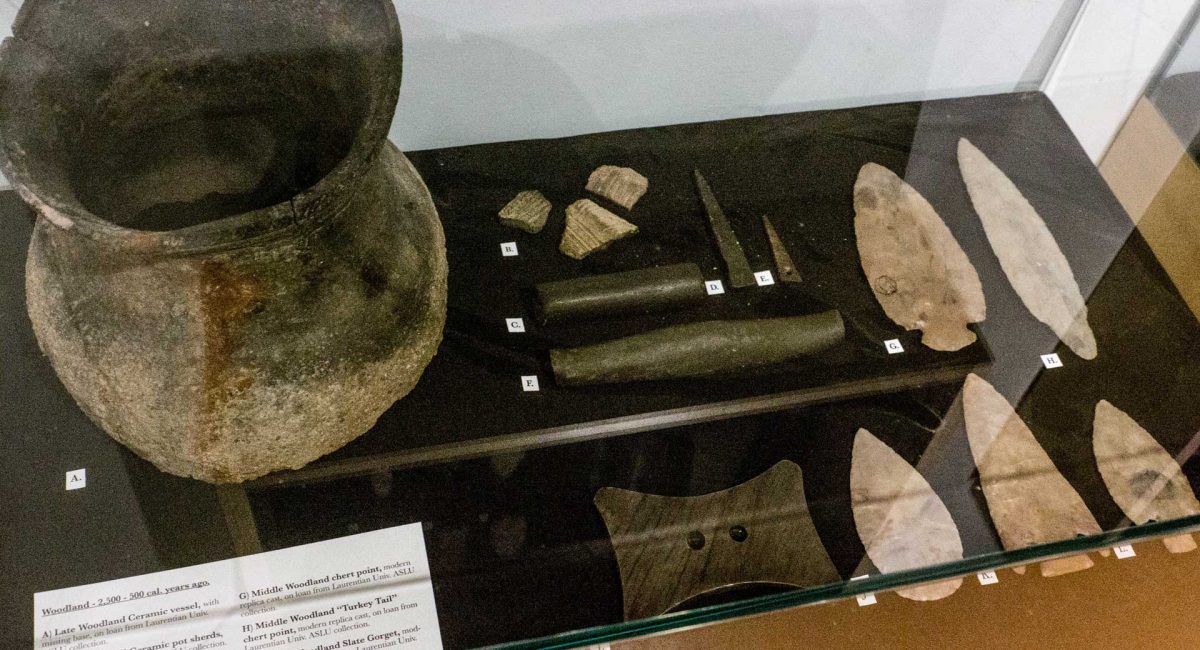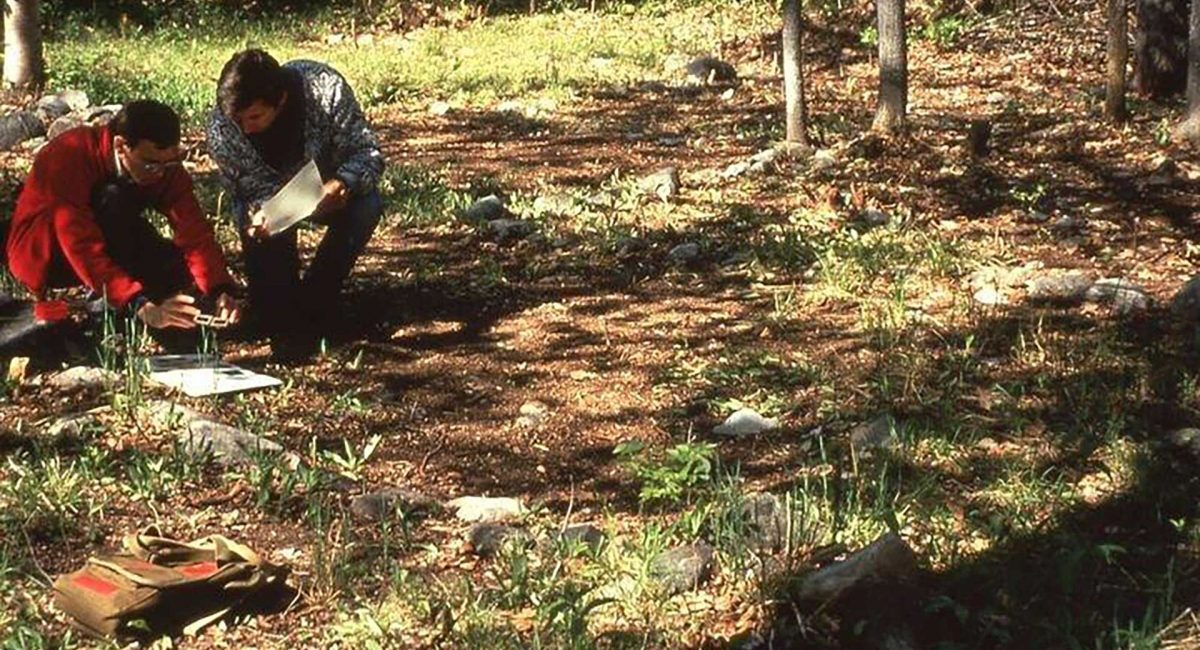Sheguiandah National Historic Site:
Twice the Age of the Pyramids of Egypt
When Thomas E. Lee, an archaeologist with the National Museum of Canada, found ancient stone implements in an Island farm field in 1951, they led him and his team to a nearby ridge of quartzite, part of the Precambrian geological formation over two billion years old that was poking out of the top of the younger rocks.
At the top of a hill in Sheguiandah, a picturesque hamlet on Highway 6 south of Little Current, Lee uncovered a stunning archeological find: a large, prehistoric quarry filled with innumerable stone tools, spearheads and scrapers that Lee claimed proved the existence of the oldest recorded humans in the Americas, some 25,000 years ago. His findings, developed before the use of carbon-dating, contradicted the ‘standard’ view – that humans came to North America after the last Ice Age, about 10,000 years ago – and were not substantiated, fueling a decades-long controversy that is still debated today.
In 1954, the hill, quartzite quarry, and the habitation area that encompasses the village of Sheguiandah were designated a National Historic Site of Canada. For over forty years after Lee’s initial digs, the site lay dormant, the land privately owned and occasionally quarried in a different location.
“The heritage value of the remains found in Sheguiandah,” reads the Canadian Register of Historic Places, “resides in a series of successive cultural occupations of early inhabitants in what is now Ontario, beginning circa 11,000 B.C.E. with the Paleo-Indian Period during the recession of glacial Lake Algonquin.
“The site also contains artifacts from the Archaic Period (1000-500 B.C.E.) as well as Point Peninsula Culture stone tools associated with the Middle Woodland Period (0 – 500 C.E.).”


These were the findings of Patrick J. Julig of Laurentian University and Peter L. Storck of the Royal Ontario Museum who led a team of specialists to re-open the quarry site in 1991. They found strong evidence that the glacial till in which Lee had found artifacts and which dated the site to 25-30,000 years ago was in a fact a much younger beach of a receding glacial lake and the effects of wind and erosion in mixing the soil had caused some artifacts to be lodged in lower, older soil strata. Julig and Storck dated the site at 9,500 carbon-dated years, after the last Ice Age, now the standard view among archaeologists.
A Geo-Archeologist, Patrick Julig has been a professor of Anthropology at Laurentian University in Sudbury since 1990, now part-time, and had been doing research on Manitoulin since 1985. He and his wife Helen bought a hobby farm in Sheguiandah in 2002, semi-retiring to the Island in 2005 – just up the road from the site of one of most exciting archeological finds of Dr. Julig’s long career.
“The new dig was a collaboration among local municipalities and First Nations; we were working with First Nations Chiefs from the beginning. The Chiefs of Sheguiandah and Aundeck Omni Kaning were involved in discussions about collaborative ventures for tourism; communication is ongoing. The First Nations did their own studies about a possible cultural or interpretive centre and there’s support from the major landowners and the Town of NEMI. Sheguiandah First Nation wants to honour their ancestors by allowing others to learn from the site.”
Also close to the archeological site on Highway 6 is the Centennial Museum of Sheguiandah, a small but significant repository of artifacts found in the nearby excavations, ancient fossils and settler implements and buildings, offering fascinating glimpses of life in this culturally diverse area from prehistory to modern days. Last fall the Museum unveiled an engaging interactive exhibit dedicated to the National Historic Site of Sheguiandah with the backing of the Town of NEMI and grants from the Northern Ontario Heritage Fund and Canadian Heritage’s Canada Cultural Spaces Fund. At last, an easy-to-navigate, fun way to learn the amazing history, geology and archeology of this important place.
Dr. Julig is chair of the Museum’s Advisory Committee and designed the content of the exhibit into the clearly delineated archaeological periods of the site that are represented by descriptive panels and accompanied by the artifacts of those periods found by Lee in the 1950s and by Julig and Storck in the 90s. Museum Curator Lisa Hallaert was keen on activities for kids, so there’s a sandbox ‘dig’ with a screen for sifting out ‘artifacts’ like shells, stones and beads and an iPad station with a custom-designed archeological game featuring Dr. Julig as a cartoon character.
Among the educational panels of photos, maps and absorbing information on the site’s history, Patrick Julig indicates a display case of artifacts from the Middle Woodland Period and points to a clay pipe. “You see that in this era, people started to smoke tobacco and they made clay pipes. The Middle Woodland is characterized by the making of pottery and copper beads. Before clay, containers were made of skin or birch bark.” A beautiful clay pot from a similar site is shown as an example of artisan work from 2,500 BCE.
“Each cultural period is an evolution into the next,” adds Dr. Julig. “Paleo-Indians used long, thin, pointy spear points for thrusting at game. The quartzite knoll in Sheguiandah was their tools workshop for centuries, and we have the evidence of their scrapers and spear points, and of heavier ‘cores’ used to chip into a spear point or to flake into scrapers or knives. The spear points of different periods also indicate different ways of throwing spears, and in the Archaic Period they were fast and accurate, using ‘atlatls’ (spear throwers) and spear points with notches.”
A welcome development of the Centennial Museum project to bring the site into the light of day is the plan to allow guided tours to the prehistoric quarry in future, pending funding and consultation with those involved. “We need a boardwalk first, and gravel paths,” says Patrick Julig. The site is fragile and vulnerable to disturbance and is protected from any encroachment by the Ontario Heritage Act and the National Historic Site designation.
To Patrick Julig, almost thirty years after the publication of his team’s findings, the Sheguiandah Archeological Site remains a place of awe: “Sheguiandah is twice the age of the Pyramids of Egypt and of Stonehenge. You can see the different ancient water levels that are clearly visible and indicate the distinctive eras, the 450 million-year-old Ordovician beach conglomerate called Mystic Ridge, the artifacts that have been lying around for thousands of years and the dug pits, now bogs, at the very top,” says the archeologist. “Because quartzite is more acidic than Manitoulin’s more usual alkaline soil, there are blueberries up there.”
Until it’s possible to tour the famous site, the Centennial Museum’s interactive exhibit will whet the appetite for the archeological wonder that is Sheguiandah.
The Centennial Museum of Sheguiandah, 10862 Highway 6, Sheguiandah. Tel: 705-368-2367 Open May to October.
